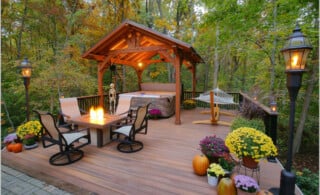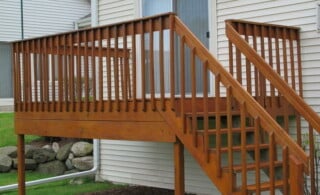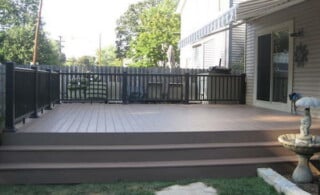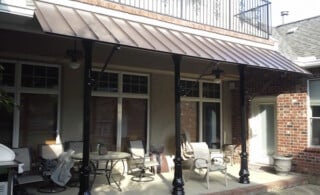
Photo: Iriana Shiyan / Adobe Stock
Decks and patios can transform an idle outdoor space into a useful and enjoyable platform for entertaining, playing, relaxing, dining, and much more. While the two terms are often used interchangeably, there are several fundamental and subtle differences between them that can help you decide which one is better for your outdoor space. The biggest difference between a deck and a patio is that a deck is built above ground level and supported by vertical wood posts and joists underneath, whereas a patio is built flush with the ground.
What Is a Deck?
A deck is a wood-framed structure located outside of, but adjacent to a house. The deck may be attached to the house or can be freestanding. It has no roof, is usually raised above the ground, and can have one or multiple height levels. A deck can also have steps as well as railings to provide safety. Because it’s raised above ground level, it’s possible to construct a deck on uneven or rocky terrain.
The most common decking material is pressure-treated wood. Options for this material include cedar, bamboo, mahogany, redwood, ipe, and pine. Other materials, like composite, aluminum, or PVC, can be used for the decking, but the basic structure of a deck is almost always made of wood.
What Is a Patio?
A patio is an outdoor space that adjoins a home, but that sits directly on the ground, unlike a deck, which is raised. Patios are usually built from concrete, stone, tile, or brick, making them more durable and long-lasting. They also require very little maintenance aside from routine cleaning.
Like a deck, a patio can be attached to or detached from a home. Because they lie directly on the ground, the area must be leveled before construction can begin. While they don’t provide as great a view of the surroundings or the horizon as a deck that’s raised, patios offer more privacy.
Appearance
A patio’s design is typically less rigid because it’s more of a landscape element than a part of the house. Patios are the best choice if you want a building that lets you show off your artistic tastes and preferences to the fullest.
| Deck | Patio |
|---|---|
| Limited in design and style due to its wooden frame | More versatile and offers more design options |
| Natural landmarks can’t be incorporated into the layout | Can design a patio to blend with natural surroundings, plus landmarks can be incorporated into its layout |
Deck
Decks are quite limited in terms of design and style because most use wood framing, which has many limitations in regards to what you can do with it. Furthermore, if natural wood decking doesn’t get the necessary treatment frequently, it can quickly lose its attractiveness and begin to look unkempt and old.
Patio
Patios offer more design options and are more versatile than decks. They come in different shapes, plus you can choose from a wide range of material options, including stone, brick, tile, and concrete. You could also stain or dye your patio to suit your preferences.
Additionally, you can design a freestanding patio to blend in with the natural surroundings. You can also incorporate landmarks around your home, like a tree or large rock, into your patio’s layout.
Cost
Building a patio is generally more cost-effective than building a deck. However, regardless of which structure you choose, the cost to install each will vary based on your location, the terrain, project size, and material you select. A local deck builder or local patio contractor can provide accurate quotes as well as advice on the best size and materials for your design.
| Deck | Patio |
|---|---|
| Higher installation cost: $30 – $60 per sq. ft. | Lower installation cost: $8 – $20 per sq. ft. |
| Costs include permits and inspection fees | No permits and inspections are required typically, and thus no fees for these |
Deck
Building a deck costs between $4,100 and $11,600, with an average total cost of $7,900. This works out to $30 to $60 per square foot.
Patio
Building a patio costs between $1,900 and $5,600, or an average project price of $3,620. This equates to about $8 to $20 per square foot. Patios generally cost less to build than decks since they are made of more affordable materials like concrete or stone. Patios don’t also require permits or inspections, which can reduce the total installation costs.
To estimate how much your patio might cost, use HomeAdvisor’s patio calculator to figure out how many stone, cement, or brick pavers and how much sand or gravel base you’ll need for the patio.
Upkeep
In general, decks require more ongoing maintenance than patios. If you’re looking for an outdoor space with minimal maintenance requirements, patios are a superior alternative to decks.
| Deck | Patio |
|---|---|
| Natural wood decks require a lot of maintenance, including staining and resealing every one or two years | No major maintenance requirements other than routine cleaning |
Deck
Natural wood decks require a lot of maintenance. This includes power-washing as well as staining and resealing every one to two years to maintain appearance and longevity. Professional deck staining costs $540 to $1,050, while the cost of refinishing a deck ranges between $600 and$1,360, or $3 to $6.80 per square foot.
You can opt for composite decking for a similar look with fewer upkeep needs, though that’ll cost you more.
Patio
Patios require little upkeep aside from the occasional hose down or pressure washing. If your patio is made of concrete, however, make sure to regularly inspect it for cracks, as these can lead to water penetrating into the subsurface and eroding it. The erosion can result in a void below the slab and cause it to sink in.
Durability
Since pros use different materials, decks and patios vary greatly regarding durability. Patios, in general, are more durable than decks. They can withstand more wear and tear, as well as natural elements.
| Deck | Patio |
|---|---|
| Natural wood is susceptible to rot, insect damage, and natural wear and tear | Made from more water-resistant and durable materials |
| No major cracking issues to worry about | Concrete patios may be prone to cracking if not laid over a strong sand or gravel bed |
Deck
Natural wood decks are susceptible to rot, insect damage, and natural wear and tear. For a more durable decking, you can opt for composite. Composite comprises a blend of plastic, wood waste, and binders. The plastic makes the decking resistant to rot, and insects dislike it. Also, composite decking doesn’t need any major maintenance other than periodic cleaning.
Patio
Patios can be made from materials like stone, which is extremely durable. They can tolerate much more rain or snow water and also don’t wear easily.
However, concrete patios are prone to cracks and shifting. You can avoid this, however, by laying the concrete slabs over a strong bed of sand or gravel.
Installation
Deck installation differs significantly from patio installation because one is typically raised while the other is flush with the ground. With decks, for example, the fact that they are raised and that they typically attach to a house means that there are more architectural and safety considerations to consider. This is why experts generally recommend leaving deck construction to professionals.
| Deck | Patio |
|---|---|
| More labor intensive and requires a professional | Easier to install |
| No major landscaping needed | Extra clearing and leveling of the ground may be needed |
Deck
Building a deck is a labor-intensive and delicate project best left to professionals. Because it’s above ground, your deck must have a solid, strong foundation that can support the weight of guests and any furniture you place on it. Furthermore, if your deck is attached to your home, you’ll need to take extra precautions to avoid compromising your home’s foundation. That’s why it’s a good idea to hire a deck carpenter or contractor to complete this project.
A deck is the better option if you have a sloping or uneven yard since additional landscaping requirements, like leveling the ground, will be unnecessary or minimal.
Patio
Installing a patio is generally easier than a deck since you don’t need to construct a frame or substructure. Plus, unlike decks, patios don’t need to attach to your home or other buildings.
However, since patios lay directly on the ground, their construction might involve extra prep work, including clearing and leveling the ground. This type of structure is, therefore, more suitable for a clear, flat, or reasonably level yard.
Life Span
Since wood is not as durable as other materials like stone, the average lifespan of a natural wooden deck is less than that of a patio. You can extend the lifespan of both types of structures, however, with proper care and maintenance.
| Deck | Patio |
|---|---|
|
Lifespan of 10 – 15 years for natural wood decking, 50 years for composite decking |
Lifespan of up to 100 years |
Deck
Natural wood decks can last for between 10 and 15 years, while some composite decks can last up to 50 years with proper maintenance.
Patio
Patios, especially those made using stone, can last up to 100 years.
Environmental Impact
Between patios and decks, patios are the more sustainable option. Patios are made of more durable materials and therefore don’t need to be replaced as often as decks.
| Deck | Patio |
|---|---|
| Made of expensive raw materials that have a shorter lifespan and can take hundreds of years to regenerate | Requires fewer (and more environmentally-friendly materials) and resources to build |
Deck
Decks can be made of old-growth trees like cedar and redwood, which take hundreds of years to regenerate. Additionally, pressure-treated wood is made with potentially carcinogenic chemicals. If these leach into the soil, they can contaminate groundwater and cause arsenic poisoning if consumed.
Composite decking can be a more environmentally-friendly option and comes from recycled products and also has a longer lifespan.
Patio
Patios are generally better for the environment than decks. They not only require fewer materials and resources to build, but the materials used to construct patios, such as stone, bricks, and cement, are extremely durable.
Resale Value
Both decks and patios can add value to your home, but decks have a better return on investment or ROI. But regardless of ROI, either a deck or a patio can be a centerpiece that makes your home stand out and helps sell it faster.
| Deck | Patio |
|---|---|
| 70% ROI on selling home | 50% ROI on selling home |
Deck
With decks, you can recoup up to 70% of your investment when selling a home. If you’re improving your home with a view to selling it, a patio is the better alternative.
Patio
You’ll recoup up to 50% of your investment on a beautifully constructed patio, which is lower than that of a deck.
Is a Deck or Patio Better for Your Home?
There is no one-size-fits-all answer to this question, as deciding whether to build a deck or patio will depend on several factors specific to your home and your needs. Some things you may want to consider include the amount of space you have available, the style of your home, the climate in your area, your budget, and your personal preferences, including what you hope to achieve with your deck or patio. Use the table below to help you decide.
| Element | Deck | Patio |
|---|---|---|
| Appearance | Fewer design and style options | More design options, can blend with the natural surroundings and can incorporate landmarks into its design |
| Cost | More upfront cost: $30 – $60 per sq. ft. | Lower upfront cost: $8 – $20 per sq. ft |
| Upkeep | More upkeep needs including staining and resealing to maintain appearance | Fewer maintenance requirements apart periodic cleaning |
| Durability | Natural wood is less durable as it’s more susceptible natural wear and tear, insect damage and rot, but composite is more durable | Made from durable materials like natural stone, brick, and cement |
| Installation | More labor intensive, and more architectural and safety aspects to consider | Easier to install, but requires extensive ground prep work |
| Lifespan | Natural wood decking has an average lifespan of 10–20 years, but composite and PVC can last up to 50 years | Can last up to 100 years |
| Environmental Impact | Less sustainable since it’s made from expensive materials that have shorter lifespan, and some of which (like cedar and redwood) can take hundreds of years to regenerate | Requires fewer and more environmentally-friendly materials and resources to build |
| Resale Value | Up to 75% return on investment when selling | Up to 50% return on investment when selling |
For Homes with Kids
For homes with kids, a deck is the best option. The railing around the outside keeps little ones safely enclosed on the deck area in sight of the supervising adults. Also, the wood surface, while still hard, is softer than stone, so it’s less likely to cause cuts, grazes, or bruises when kids inevitably fall down on it.
For Yards with Firepits
If you’re creating an outdoor area with a firepit as the central feature, a patio is the smartest option, as, if you choose the right stone, it’s impervious to the heat from the firepit. If your heart is set on a deck, you’ll need a fire table or a natural gas fire pit that won’t easily set fire to your deck.
Best for Privacy
Since patios are usually at ground level, they offer the best privacy especially if you enclose yours with walls and a roof. Building an enclosed patio costs between $8,324 and $25,919.
But while decks afford less privacy, they offer a better view of the yard and surrounding area because of their elevated position. That said, if you want to enjoy a better view of your surroundings without the drawbacks of a deck, you can opt for a raised patio. Installing a raised patio costs between $10 and $85 per square foot.
Find a Deck Installation Pro Near You Cool Deck Design Ideas to Improve Your Outdoor Living Space
Cool Deck Design Ideas to Improve Your Outdoor Living Space  Outdoor Rooms: Enhance Your Outdoor Living
Outdoor Rooms: Enhance Your Outdoor Living  Deck Mold and Mildew
Deck Mold and Mildew  Composite Decking
Composite Decking  Aluminum Awnings: Made for Shade
Aluminum Awnings: Made for Shade 

Are You Familiar With This Topic? Share Your Experience.